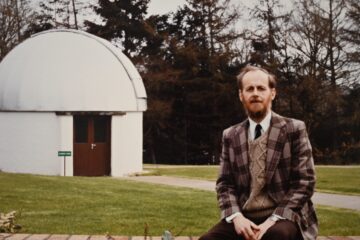The NASA/ESA’s Hubble Space Telescope has tracked the fading light of a supernova in the spiral galaxy NGC 2525, located 70 million light years away. Supernovae like this one can be used as cosmic tape measures, allowing astronomers to calculate the distance to their galaxies.
Hubble captured these images as part of one of its major investigations, measuring the expansion rate of the Universe, which can help answer fundamental questions about our Universe’s very nature.
The supernova, formally known as SN2018gv, was first spotted in mid-January 2018. The NASA/ESA’s Hubble Space Telescope began observing the brilliant brightness of the supernova in February 2018 as part of the research program led by lead researcher and Nobel Laureate Adam Riess of the Space Telescope Science Institute (STScI) and Johns Hopkins University, in Baltimore, USA. The Hubble images center on the barred spiral galaxy NGC 2525, which is located in the constellation of Puppis in the Southern Hemisphere.

Credit: ESA/Hubble & NASA, A. Riess and the SH0ES team. Acknowledgment: Mahdi Zamani
The supernova is captured by Hubble in exquisite detail within this galaxy in the left portion of the image. It appears as a very bright star located on the outer edge of one of its beautiful swirling spiral arms. This new and unique time-lapse of Hubble images created by the ESA/Hubble team shows the once bright supernova initially outshining the brightest stars in the galaxy, before fading into obscurity during the year of observations. This time-lapse consists of observations taken over the course of one year, from February 2018 to February 2019.
“No Earthly fireworks display can compete with this supernova, captured in its fading glory by the Hubble Space Telescope,” shared Riess of this new time-lapse of the supernova explosion in NGC 2525.
Supernovae are powerful explosions which mark the end of a star’s life. The type of supernova seen in these images, known as a Type Ia supernova, originate from a white dwarf in a close binary system accreting material from its companion star. If the white dwarf reaches a critical mass (1.44 times the mass of our Sun), its core becomes hot enough to ignite carbon fusion, triggering a thermonuclear runaway process that fuses large amounts of oxygen and carbon together in a matter of seconds. The energy released tears the star apart in a violent explosion, ejecting matter at speeds up to 6% the speed of light and emitting huge amounts of radiation. Type Ia supernovae consistently reach a peak brightness of 5 billion times brighter than our Sun before fading over time.

Credit: ESA/Hubble & NASA, A. Riess and the SH0ES team. Acknowledgment: Mahdi Zamani
Because supernovae of this type produce this fixed brightness, they are useful tools for astronomers, known as ‘standard candles’, which act as cosmic tape measures. Knowing the actual brightness of the supernova and observing its apparent brightness in the sky, astronomers can calculate the distance to these grand spectacles and therefore their galaxies. Riess and his team combined the distance measurements from the supernovae with distances calculated using variable stars known as Cepheid variables. Cepheid variables pulsate in size, causing periodic changes in brightness. As this period is directly related to the star’s brightness, astronomers can calculate the distance to them: allowing them to act as another standard candle in the cosmic distance ladder.
A supermassive black hole is also known to be lurking at the centre of NGC 2525. Nearly every galaxy contains a supermassive black hole, which can range in mass from hundreds of thousands to billions of times the mass of the Sun.



0 Comments